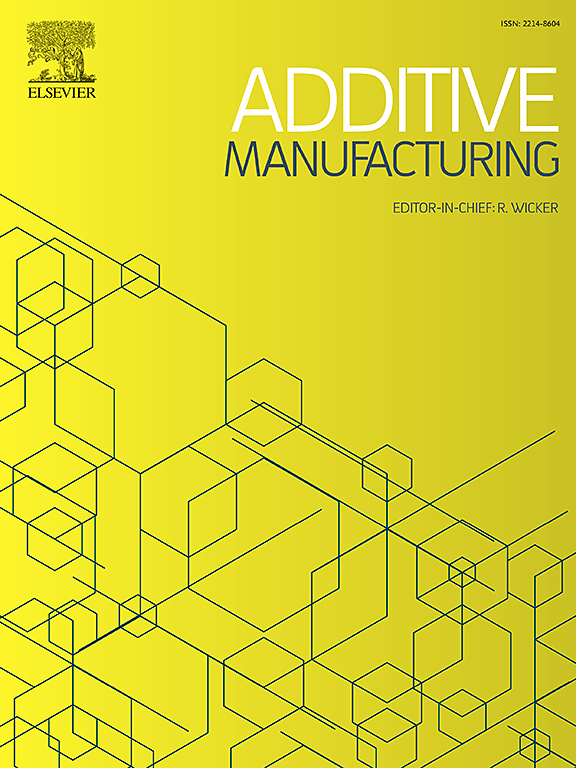Unveiling ultra-stable cyclic martensitic transformation behavior of an additively manufactured NiTiCu shape memory alloy
IF 10.3
1区 工程技术
Q1 ENGINEERING, MANUFACTURING
引用次数: 0
Abstract
Additively manufactured (AM) nickel-titanium (NiTi) shape memory alloys (SMAs) often suffer from functional fatigue due to intrinsic large hysteresis and process complexities during cyclic operation. This study, by optimizing lattice compatibility between the parent and martensitic phases, presents a laser-directed energy deposited (LDED) Ni40-Ti50-Cu10 (at%) SMA that simultaneously achieves low hysteresis and enhanced cyclic stability in martensitic transformation behavior. Only 0.31°C of martensitic transformation temperature shift was observed after 50 thermal cycles, significantly outperforming conventional SMAs. The non-equilibrium solidification of the LDED process generates cross-scale microstructures and a distinct (100) growth texture, while excellent lattice compatibility restricts martensitic variants to favorable orientations of (010)B2 || (001)B19 and (101)B2 || (010)B19. Dominant (011) type I twin relationship between martensitic variants is observed with coherent twin interfaces. These characteristics reduce the energy barrier at the phase transition interface, effectively mitigating interface stress and preventing irreversible defects, minimizing hysteresis, and ensuring ultra-stable cyclic martensitic transformation. Additionally, Ti2Cu precipitates, formed at twin ridges due to cyclic heating during fabrication, pin dislocations and prevent their movement across twin interfaces, ensuring repeatability and reversibility in each cycle. The utilization of pre-alloyed powder guarantees macroscopic uniformity in phase composition and transition behavior, resulting in consistent cycle stability along the build direction. This study provides new insights into the high cyclic stability of LDED-fabricated NiTiCu10 SMAs and advances the development of high-performance SMAs with degradation-free cyclic phase transformation using AM technology.
揭示了一种增材制造NiTiCu形状记忆合金的超稳定循环马氏体相变行为
增材制造(AM)镍钛形状记忆合金(SMAs)由于其固有的大滞后和工艺复杂性,在循环运行过程中经常遭受功能疲劳。本研究通过优化母相和马氏体相之间的晶格相容性,提出了一种激光定向能量沉积(LDED) Ni40-Ti50-Cu10 (at%) SMA,同时实现了马氏体相变行为的低滞后和增强的循环稳定性。经过50个热循环后,其马氏体相变温度变化仅为0.31℃,明显优于传统sma。LDED过程的非平衡凝固产生了跨尺度的微观组织和明显的(100)生长织构,而优异的晶格相容性限制了马氏体变异的有利取向,即(010)B2 || (001)B19和(101)B2 || (010)B19。马氏体变体之间的显性(011)I型孪晶关系在共相干孪晶界面中观察到。这些特性降低了相变界面的能垒,有效地减轻了界面应力,防止了不可逆缺陷的发生,最大限度地减少了迟滞,确保了超稳定的循环马氏体相变。此外,由于在制造过程中循环加热,在双脊处形成Ti2Cu沉淀,引脚位错并阻止其在双界面上移动,确保了每个循环的可重复性和可逆性。预合金粉末的使用保证了相组成和转变行为的宏观均匀性,从而在构建方向上保持一致的循环稳定性。该研究为led制造的NiTiCu10 SMAs的高循环稳定性提供了新的见解,并推动了使用AM技术实现无降解循环相变的高性能SMAs的发展。
本文章由计算机程序翻译,如有差异,请以英文原文为准。
求助全文
约1分钟内获得全文
求助全文
来源期刊

Additive manufacturing
Materials Science-General Materials Science
CiteScore
19.80
自引率
12.70%
发文量
648
审稿时长
35 days
期刊介绍:
Additive Manufacturing stands as a peer-reviewed journal dedicated to delivering high-quality research papers and reviews in the field of additive manufacturing, serving both academia and industry leaders. The journal's objective is to recognize the innovative essence of additive manufacturing and its diverse applications, providing a comprehensive overview of current developments and future prospects.
The transformative potential of additive manufacturing technologies in product design and manufacturing is poised to disrupt traditional approaches. In response to this paradigm shift, a distinctive and comprehensive publication outlet was essential. Additive Manufacturing fulfills this need, offering a platform for engineers, materials scientists, and practitioners across academia and various industries to document and share innovations in these evolving technologies.
 求助内容:
求助内容: 应助结果提醒方式:
应助结果提醒方式:


